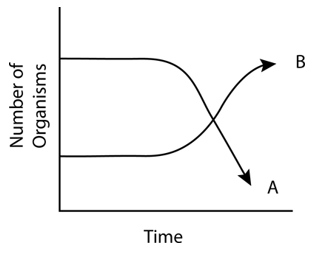An association of individuals of different species living in the same habitat and having functional interactions is known as:
| 1. | Ecological niche | 2. | Biotic community |
| 3. | Ecosystem | 4. | Population |
In which of the following interactions both partners are adversely affected?
| 1. | Competition | 2. | Predation |
| 3. | Parasitism | 4. | Mutualism |
The following graph depicts changes in two populations (A and B) of herbivores in a grassy field. A possible reason for these changes is that:

| 1. | both plant populations in this habitat decreased |
| 2. | population-B competed more successfully for food than population-A |
| 3. | population-A produced more offspring than population-B |
| 4. | population-A consumed the members of population-B |
A sedentary sea anemone gets attached to the shell lining of a hermit crab. The association is:
1. Symbiosis
2. Commensalism
3. Amensalism
4. Ectoparasitism
A biologist studied the population of rats in a barn. He found that the average natality was 250, average mortality 240, immigration 20 and emigration 30. The net increase in population is:
| 1. | 15 | 2. | 05 |
| 3. | zero | 4. | 10 |
According to Darwin, organic evolution is due to:
| 1. | Interspecific competition. |
| 2. | Competition within closely related species. |
| 3. | Reduced feeding efficiency in one species due to the presence of interfering species. |
| 4. | Intraspecific competition. |
1. high percentage of old individuals
2. low percentage of young individuals
3. a stable population
4. high percentage of young individuals
1. Development of adhesive organs
2. Loss of digestive organs
3. Loss of reproductive capacity
4. Loss of unnecessary sense organs
People who have migrated from the planes to an area adjoining Rohtang Pass about six months back:
| 1. | Have more RBCs and their haemoglobin has a lower binding affinity to 02 |
| 2. | Are not physically fit to play games like football |
| 3. | Suffer from altitude sickness with symptoms like nausea, fatigue, etc. |
| 4. | have the usual RBC count but their haemoglobin has a very binding affinity to 02 |
Cuscuta is an example of:
1. Brood parasitism
2. Predation
3. Endoparasitism
4. Ectoparasitism
